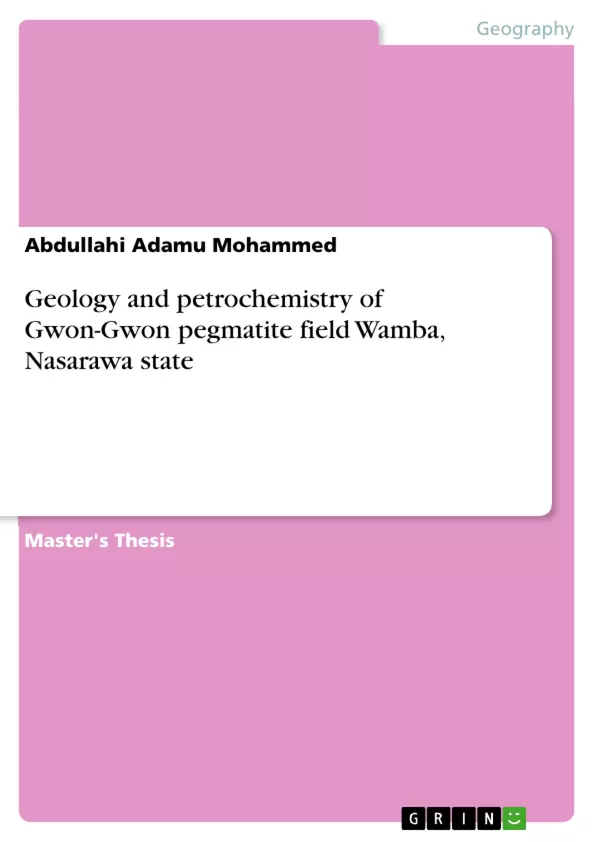Pegmatites are coarse grained igneous and metamorphic rocks. They represent the end product of magmatic stage in the evolution of granitic melt. The rare-metals (rare-elements) that serve as petrogenetic indicators (geochemical indicators) and potential ore indicators are Rb, Cs, Li, Sn, Ta, Nb, Be and W, also volatiles, like B,F,H2O play a very important role in the whole process. Pegmatites research in Nigeria from 1946 to 1989 by Jacobson and Webb, ( 1946) and Matheis and Kuster, (1989), Matheis,(1989), Matheis and Cean- Vanchette, ( 1983), use the rare-elements as tin indicators but petrology was not the main target.
Inhaltsverzeichnis (Table of Contents)
- Abstract
- Dedication
- Acknowledgement
- List of Figures
- List of Tables
- Chapter One: Introduction
- 1.1 Background of Study
- 1.2 Statement of the Problem
- 1.3 Objectives of the Study
- 1.4 Scope and Limitation of the Study
- 1.5 Significance of the Study
- 1.6 Location and Accessibility of the Study Area
- Chapter Two: Literature Review
- 2.1 Pegmatite: Mineralogy and Classification
- 2.2 Genesis of Pegmatite
- 2.3 Geological Setting of the Study Area
- 2.4 Previous Work Done on Pegmatite in Nigeria
- Chapter Three: Materials and Methods
- 3.1 Field Techniques
- 3.2 Petrographic and Geochemical Techniques
- Chapter Four: Results
- 4.1 Geological Setting
- 4.2 Petrography
- 4.3 Geochemistry
- Chapter Five: Discussion
- 5.1 Genesis and Emplacement of the Pegmatite
- 5.2 Geochemical Characteristics and Mineralization
- 5.3 Economic Significance
- Chapter Six: Conclusion and Recommendations
Zielsetzung und Themenschwerpunkte (Objectives and Key Themes)
This thesis focuses on a detailed geological and petrochemical study of the Gwon-Gwon pegmatite field, located in Wamba, Nasarawa State, Nigeria. The objectives of the study include characterizing the geological setting, examining the petrography and mineralogy, and analyzing the geochemical characteristics of the pegmatite.- Understanding the geological processes involved in the formation and emplacement of the Gwon-Gwon pegmatite field.
- Investigating the petrographic and mineralogical features of the pegmatite, identifying the different mineral assemblages and their significance.
- Analyzing the geochemical characteristics of the pegmatite, particularly the major and trace element composition, to determine its genesis and economic potential.
- Assessing the economic potential of the Gwon-Gwon pegmatite field for the extraction of valuable minerals.
- Providing insights into the geological evolution of the study area and the role of pegmatites in the regional mineralization context.
Zusammenfassung der Kapitel (Chapter Summaries)
- Chapter One provides an introduction to the study, highlighting the significance and objectives of the research. It establishes the context for the study, outlining the background, location, and accessibility of the Gwon-Gwon pegmatite field.
- Chapter Two presents a comprehensive review of existing literature on pegmatites, focusing on their mineralogy, genesis, geological setting, and previous research in Nigeria. This chapter serves as a framework for understanding the broader context of the Gwon-Gwon pegmatite field within the existing knowledge of pegmatite formation and occurrences.
- Chapter Three details the materials and methods employed in the study. It describes the field techniques used for data collection and the petrographic and geochemical techniques applied to analyze the rock samples.
- Chapter Four presents the results of the study, focusing on the geological setting, petrography, and geochemistry of the Gwon-Gwon pegmatite field. It provides detailed descriptions of the rock formations, mineral assemblages, and elemental composition.
- Chapter Five discusses the findings presented in Chapter Four, interpreting the genesis and emplacement of the pegmatite, analyzing its geochemical characteristics, and assessing its economic potential.
Schlüsselwörter (Keywords)
This research explores the geological and petrochemical characteristics of the Gwon-Gwon pegmatite field in Wamba, Nasarawa State, Nigeria. Key terms include: pegmatite, petrography, geochemistry, geological setting, mineralization, economic potential, and the study area's geological evolution.
Ende der Leseprobe aus 97 Seiten
- nach oben
- Arbeit zitieren
- Abdullahi Adamu Mohammed (Autor:in), 2011, Geology and petrochemistry of Gwon-Gwon pegmatite field Wamba, Nasarawa state, München, GRIN Verlag, https://www.grin.com/document/272264
Blick ins Buch



